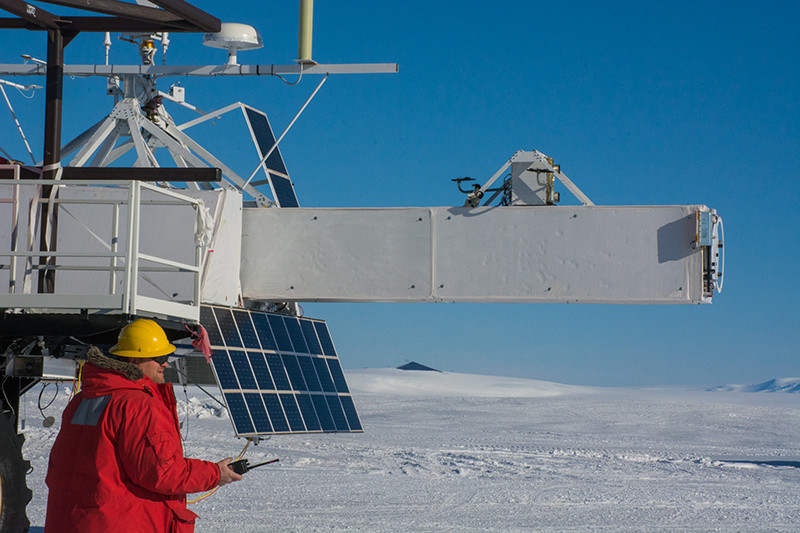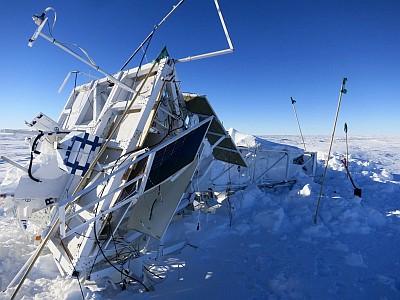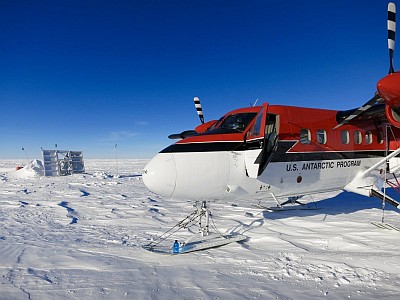News Archive
-
January, 20 2017
GRIPS instrument succesfuly recovered
South Pole Station, Antarctica.- About 21:30 utc on January 30, 2016 a strange artifact which descended in an orange and white parachute, altered the windy and isolated landscape of the Pensacola Mountains, in Antarctica. The device resembling a giant seesaw, impacted the ice, crushing part of its structure.
A few days after, a small recovery team reached the scene in a plane and rushed to the downed instrument to recover its precious cargo: a set of data drives containing the information obtained during the 11 days and 19 hours it circled the Antarctic stratosphere hanging from a giant stratospheric balloon.
The instrument in question is GRIPS (Gamma-Ray Imager/Polarimeter for Solar flares) a "telescope" developed by the University of California, Berkeley along with NASA's Goddard Space Flight Center; The Lawrence Berkeley National Laboratory; the University of California, Santa Cruz and the Nagoya University from Japan.
GRIPS science goal during the trip was to closely observe the sun trying to catch a flare. The final scientific objective of the entire program is to shed more light on how these solar flares accelerate charged particles up to nearly the speed of light both on our own sun, and on astrophysical objects throughout the cosmos.

The instrument was launched on January 19th, 2016 from the Williams Field airport near McMurdo station in Antarctica by a team of the Columbia Scientific Balloon Facility (CSBF). The campaign which was planned to sent aloft two instruments in early December 2015, faced one of the most uncooperative climates in NASA's history of Antarctic balloon operations, and forced to launch only one of the payloads. As a result of the late launch date into the season, it was necessary to left the GRIPS remains in the field a full year.
Althought the core of the mission was saved when data vaults were recovered after the flight, what was left on the ice, was by no means simply "garbage". On the contrary, several elements were unique, being very expensive to replace and also representing years of work of development. Thus, almost a year after, and while another balloon launch campaign was taking place at McMurdo (this time with excelent results), Hazel Bein and Nicole Duncan, two scientists part of the team that participated of GRIPS launch, returned to the white continent to reclaim "their baby" from one year of snow, ice and desolation.

They arrived at McMurdo on late November and after the mandatory survival course known as "Deep Field Shakedown" (to train camping in the cold as well as trying emergency equipment and survival techniques) they prepared the equipment they would need, and send it to the Amundsen-Scott South Pole Station, from were the recovery operation would be staged.
They reached the Pole Station on December 5 and after a little more field safety training while awaiting the arrival of the Twin Otter plane to be used in the operation, they meet their companion team of mountaineering experts which would guide and assist them in the recovery effort. After plane's arrival, when all seemed to be ready for the first reconnaisance flight, the weather deteriorated enough to halt the expedition. Day after day, the climate refused to allow the plane to fly, and as a result they spent almost 15 days motionless at Amundsen-Scott. The new year arrived, and finally on January 2 the weather eased and finally the Twin Otter departed for the landing site.
Judging by the picture above at left, what they found seemed to be discouraging, but after close inspection, the impact and the long year on an extreme climate affected -as expected- the "soft" elements of the structure like the solar panels, but the main parts of the instrument were in good shape. During that first trip the team recovered the Cryostat, that is the "heart" of the instrument, which was returned at once to the Pole station.
Four days later, they returned to the landing spot on a second recovery trip, a very "tactical" operation which was completed in 90 minutes returning to the home base with other important science items and one of the additional instruments which "piggybacked" on the gondola: SOLAR-T.

A third and last flight took place a few days later, and this time -thanks to the good weather- the team recovered the remaining electronic parts of GRIPS. After a mid-way refueling stop, on January 8, they completed the operation. Behind, on the field, were only left the "bones" of the instrument, composed mainly by the gondola structure and other items whose recovery was worthless.
All the elements recollected from the landing site were transported days after from the South Pole on a LC-130 plane back to McMurdo station. Once there were carefully packed and loaded in a sea container to be shipped back to the United States on station's resupply vessel.
Note: I want to thank Hazel Bain for the information which made possible this little account. She shared on his Twitter account, (@hazbain) and also in the project's account (@GRIPSballoon) they particular adventure as long as she could obtain access to an internet connection, which in some circumstances in Antarctica, could be a luxury... finally , if you find this account a bit epic, don't blame me but Hans Zimmer's INTERSTELLAR soundtrack which played in the background as I wrote it.
-
Share this on social media


